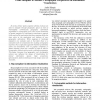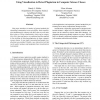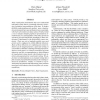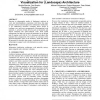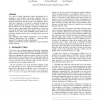128
click to vote
INFOVIS
2000
IEEE
15 years 5 months ago
2000
IEEE
A sequential pattern in data mining is a finite series of elements such as A → B → C → D where A, B, C, and D are elements of the same domain. The mining of sequential patte...
112
click to vote
INFOVIS
2000
IEEE
15 years 5 months ago
2000
IEEE
In the last several years, large multi-dimensional databases have become common in a variety of applications such as data warehousing and scientific computing. Analysis and explor...
109
Voted
INFOVIS
2000
IEEE
15 years 5 months ago
2000
IEEE
Radial, space-filling visualizations can be useful for depicting information hierarchies, but they suffer from one major problem. As the hierarchy grows in size, many items becom...
108
click to vote
INFOVIS
2000
IEEE
15 years 5 months ago
2000
IEEE
By virtue of their spatio-cognitive abilities, humans are able to navigate through geographic space as well as meaningfully communicate geographic information represented in carto...
INFOVIS
2000
IEEE
15 years 5 months ago
2000
IEEE
This paper introduces a number of general methods for visualizing commonality in sets of text files. Each visualization simultaneously compares one file in the set to all other ...
80
Voted
INFOVIS
2000
IEEE
15 years 5 months ago
2000
IEEE
106
click to vote
INFOVIS
2000
IEEE
15 years 5 months ago
2000
IEEE
Data visualization environments help users understand and analyze their data by permitting interactive browsing of graphical representations of the data. To further facilitate und...
109
Voted
INFOVIS
2000
IEEE
15 years 5 months ago
2000
IEEE
In previous work, researchers have attempted to construct taxonomies of information visualization techniques by examining the data domains that are compatible with these technique...
87
Voted
INFOVIS
2000
IEEE
15 years 5 months ago
2000
IEEE
Drawing on ethnographic studies of (landscape) architects at work, and interdisciplinary cooperation with them, this paper presents a human-centered approach to information visual...
INFOVIS
2000
IEEE
15 years 5 months ago
2000
IEEE
Two tasks in Graph Visualization require partitioning: the assignment of visual attributes and divisive clustering. Often, we would like to assign a color or other visual attribut...

